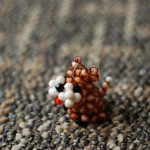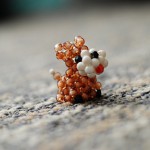“Duan Wu Jie (端午節) is a Chinese holiday that is celebrated on the fifth day of the fifth lunar month of every year. It is an official Chinese holiday. What you do is eat zongzi (粽子) which is a type of Chinese delicacy, uh, it’s sort of a, um, dim sum, but not really a dim sum. It’s just a cuisine. You wrap rice—a special type of rice, those sticky rice—um, inside a leaf and steam it or poach it in water. It has a lot of flavors and a lot of different types of fillings. Once you put the meats and flavors and fillings inside the marinated rice, you wrap it in the leaves, tie it with string, and cook it. The reason behind eating it has to go with a story behind it:
“There used to be a Chinese politician back then—it’s a long time ago—and, um, he was very loyal to his country. He warned his country and his king about what he should do before something goes wrong. He knew something was wrong and that the other country would invade them, but the king wouldn’t listen to his advice, uh, so the tragic happened: people came and invaded the entire country. He was very disappointed and very saddened, but he was still very loyal to his country. So he committed suicide in the pond. And the people found out on the fifth day of the fifth lunar month. And the people loved that politician and wanted to commemorate his death—they threw the, uh, zongzi inside the water so that the fish would not eat his body but eat the food instead. So that tradition of eating zongzi came from that. Although it was meant for fish originally, we eat it still.
“This festival is also known as the Dragon Boat Festival. So people race dragon boats. Um, apparently that day is also the day when the sun and dragon come out at the same time or something, and it’s a symbol of masculinity, I guess, to race dragon boats.”
Q: “I have also heard another version where the reason the dragon boats are raced is to go out and find this war hero/politician guy. Have you heard of this version?”
A: “I’m pretty sure that is probably another version of the story. I’m pretty sure they are still searching for his body, and they haven’t found it yet.”
Q: “And what else do you do on this day?”
A: “Well, it’s a public holiday so you kinda stay with your family and do something fun like go out and watch a film.”
Q: “So it’s mainly just the families that congregate together? Or does the whole community get together and perform?”
A: “If you break it down, it’s more family-oriented. Everybody has no work—you don’t have to go to work that day—so families come together, you know? It’s supposed to be a national thing, but some people celebrate it, some people don’t. It’s not a mandatory thing. In our family, we just eat the zongzi that our grandmother made. We don’t really celebrate, but it’s more of a family tradition now. There’s special TV programs on that day—a lot of people singing, but I don’t think there’s any particular song that I know of that reflects that particular day.”
Q: “What about preparation? Is there a lot of preparation for this day?”
A: “Of course. The food—at least my grandmother started preparing a few weeks beforehand. Actually, we started eating a few weeks before that day.”
Q: “Who usually is involved in preparation? Is it mainly the women? Or does the whole family get involved?”
A: “Yeah, it used to be like that, but now more and more people buy it from the store. Which is very sad because the women in metropolitan areas are too lazy to learn and carry on the tradition. Including my mom. She complains a lot about how she doesn’t have time—actually, she says it’s too hard.”
Q: “Then it is mainly the women?”
A: “I guess it’s part of the tradition, but it doesn’t have to be. It’s just sort of understated, you know?”
Through my interview with my informant, I feel that the tradition is not very well kept and persistent in his family. The holiday is large enough to gain all working people and all school children the day off, but his experience with the holiday itself is rather minimal. There is a huge concentration on the food aspect of this holiday because of the story that goes along with the traditional food. The dragon boat races are also a large part of the holiday. Since the holiday is so centered on the story of the suicidal politician, the events that characterize this celebration are related in some way to the disappearance of the great politician. The food is symbolic of the people’s efforts to try and protect his body, and the dragon boat races are held to send teams out to try and find the body before the fish or currents could carry it away. Even the mindset of dragon boat racing is considered “masculine” because the man everyone is searching for was masculine. Also playing into that machismo state of mind is the fact that the women are often left to prepare the food for this holiday. The making of zongzi is a rather long and difficult process if done correctly, so the women must spend lots of time in preparation for the holiday—weeks, according to my informant. The women are placed in their domestic places while the men are left to go out and be breadwinners for the family. Though we live in an era of progress and supposed equality, the holiday times seem to take on a more sexist role and place women back in households if they are to be considered “good wives.” It is also interesting that because less and less women (whose responsibility it is apparently to learn how to make zongzi) want to spend time slaving away in kitchens, more and more people are going out to purchase ready-made zongzi from the stores. The holiday has become commercialized. And since the holiday is so heavily concentrated on the aspect of food, it is odd that the great preparation of the food has been completely removed from the picture of this holiday and left in the hands of businesses. Because of this trend toward store-bought goods, I feel like the holiday is beginning to lose its significance and steadfastness in the families that had once spent many weeks prepping for and celebrating. In the case of my informant, for instance, who mentioned that families would rather go out and see a movie together than actually celebrate the holiday, it seems like as the generations drift further and further away from a domesticated lifestyle, the less likely it is that the traditions of the Dragon Boat Festival will be maintained within families.



